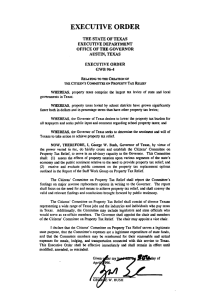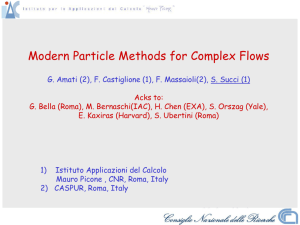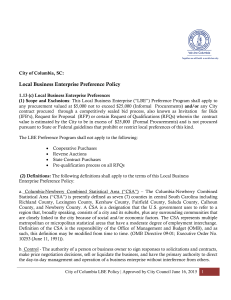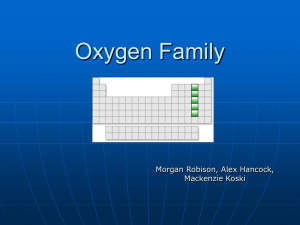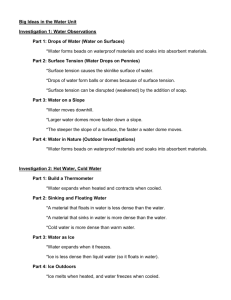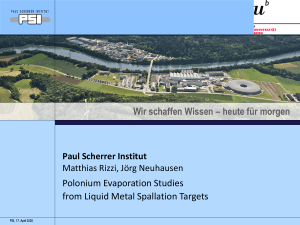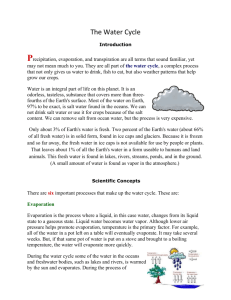Online resource - Springer Static Content Server
advertisement
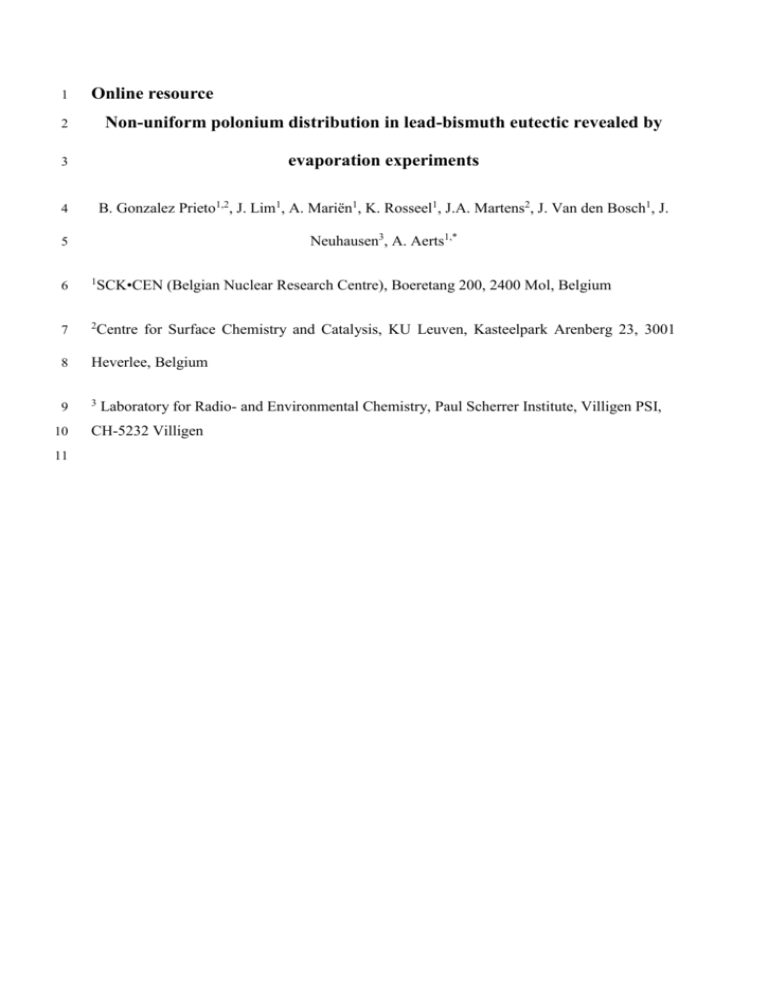
1 Online resource 2 Non-uniform polonium distribution in lead-bismuth eutectic revealed by 3 evaporation experiments 4 B. Gonzalez Prieto1,2, J. Lim1, A. Mariën1, K. Rosseel1, J.A. Martens2, J. Van den Bosch1, J. 5 Neuhausen3, A. Aerts1,* 6 1 SCK•CEN (Belgian Nuclear Research Centre), Boeretang 200, 2400 Mol, Belgium 7 2 Centre for Surface Chemistry and Catalysis, KU Leuven, Kasteelpark Arenberg 23, 3001 8 Heverlee, Belgium 9 3 10 11 Laboratory for Radio- and Environmental Chemistry, Paul Scherrer Institute, Villigen PSI, CH-5232 Villigen 12 1. Evaporation experiments in pure Ar 13 The effect of the presence of hydrogen in the flowing gas was studied by performing time 14 dependent release experiments in pure Ar. The results expressed as partial polonium 15 pressures, together with the results in Ar/5%H2 at corresponding temperatures, are shown in 16 Fig. OR1. The experiments in Ar also initially showed a high partial pressure which at longer 17 experiment times decreased towards values expected from the high temperature correlation. 18 Compared to the results obtained in Ar/5%H2, the results in Ar showed more scatter, but the 19 general trends were similar. 20 21 22 23 Fig. OR1 Corresponding evolution of the Po partial pressure after different heating times, at 24 various temperatures in: (a) Ar/5%H2 and (b) pure Ar. Dotted horizontal lines indicate the 25 calculated partial pressures of Po according to the high-temperature correlation (Eq. (1) and 26 Henry's law) 27 28 29 30 2. First-order model of Po evaporation from LBE 31 Consider an evaporation tube loaded with a small sample of Po-doped LBE of mass mlbe (see 32 Fig. OR2). The concentration of Po is very low so the mass of Po is negligible compared to 33 the sample mass, mPo(lbe) << mlbe. 34 35 36 Fig. OR2 Sketch of the transpiration tube containing a Po doped LBE sample during 37 evaporation experiments. 38 39 Through the tube carrier gas flows with volumetric flow rate 𝑉̇ . When the carrier gas flows 40 over the sample, it picks up Po(g) that evaporates from the sample, reaching a partial pressure 41 pPo. The Po(g) vapors are transported downstream of the sample through advection only 42 (diffusive transport is considered negligible). This assumption is expected to be valid under 43 the experimental conditions of the current paper (flow of carrier gas at 100 mL min-1 at STP), 44 as suggested by flow-rate dependent evaporation experiments reported in Ref.[1]. The same 45 set of experiments indicated that the evaporation equilibrium is closely approximated. 46 Assuming Po(g) behaves as an ideal gas, the rate of transport of polonium vapors, and, by 47 conservation of mass, the rate at which the LBE sample looses Po is given by: 48 𝑑𝑛Po(𝑙𝑏𝑒) 𝑑𝑡 =– 𝑝Po 𝑉̇ 𝑅𝑇 (OR_1) 49 where nPo(lbe) is the molar amount of Po dissolved in LBE and pPo is the partial pressure of 50 (monoatomic) Po vapor species [Pa] above the LBE sample. 51 Since Po is present in a very low concentration in liquid LBE, it was further assumed that the 52 equilibrium partial pressure of Po depends directly on Po concentration on the bulk of the 53 LBE sample, according to Henry's law: 54 𝑝Po = 𝐾Po(lbe) 𝑥Po(lbe) = 𝐾Po(lbe) 55 where KPo(lbe) is the Henry constant [Pa], xPo(lbe) is the mole fraction of Po dissolved in LBE, 56 mlbe(0) is the initial mass of LBE sample [g] and Mlbe is the molecular weight of LBE (208.2 g 57 mol-1). We confirmed the validity of Henry's law in the mole fraction range xPo(lbe)=10-13 to 58 10-11 [2]; by comparison with literature data Henry's law seems to be valid up to at least 10-8 59 mole fraction. 𝑛Po(lbe) 𝑀𝑙𝑏𝑒 (OR_2) 𝑚𝑙𝑏𝑒 (0) 60 61 Substitution of Eq. (OR_2) in (OR_1) and subsequent integration gives an expression for the 62 decrease of the amount of Po in the LBE sample during time-dependent evaporation 63 experiments: 64 𝑛Po(lbe) (𝑡) 𝑛Po(lbe) = exp [– (0) 𝐾Po(lbe) 𝑀lbe 𝑉̇ 𝑚lbe (0)𝑅𝑇 𝑡] (OR_3) 65 Eq. (4) of the manuscript is a linear combination of two of these equations. 66 Finally, diffusion transport limitations of Po in the bulk of the LBE sample to the surface are 67 not included in the model of Eq. (OR_3). For bulk polonium, these were however found to 68 have a negligible influence on evaporation under the conditions of the present paper according 69 to the results in Ref. [1]. Still, the influence of diffusion on the evaporation of the fraction of 70 surface polonium may be different to that of the bulk polonium. Currently we assume that the 71 surface polonium is incorporated in a solid oxide layer floating on top of the liquid LBE. 72 Because it is solid, diffusion of polonium in this layer should be very slow, so if diffusion is 73 controlling the evaporation rate of surface polonium, it would certainly not result in the 74 observed very high evaporation rates. Therefore, we believe other, currently unknown, 75 mechanisms are dominating the observed evaporation behavior of the surface polonium. The 76 model of Eq. (4) does probably not accurately describe the evaporation mechanism of the 77 surface polonium, but it provides a means to quantify the observed phenomena and allows for 78 comparison to the better-known bulk evaporation behavior. 79 References 80 81 [1] Gonzalez Prieto B, Marino A, Lim J, Rosseel K, Martens JA, Rizzi M, Neuhausen J, Van 82 den Bosch J, Aerts A (2014) Use of the transpiration method to study polonium evaporation 83 from liquid lead-bismuth eutectic at high temperature. Submitted to Radiochim Acta 84 [2] Gonzalez Prieto B, Van den Bosch J, Martens JA, Neuhausen J, Aerts A (2013) 85 Equilibrium evaporation of trace polonium from liquid lead-bismuth eutectic at high 86 temperature. J Nucl Mater. Doi: http://dx.doi.org/10.1016/j.jnucmat.2013.06.037 87
